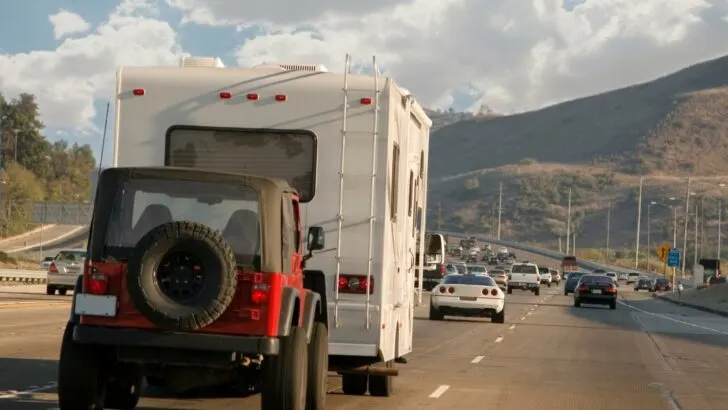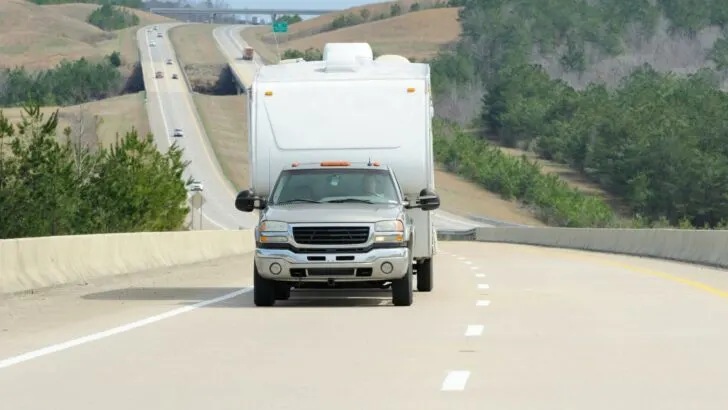Shortly after we published our post entitled “What Is Tongue Weight and Why Is It Important?”, we noted a comment from a reader who suggested that we write a post specifically dedicated to methods for trailer sway control (thanks, Eric!).
So, in today’s post, we’re looking straight at trailer sway – what it is, how to prevent it, and how to control it when it happens. We’ll also include some general towing tips while we’re on the subject.
This is important information for anyone who tows anything (even a flat-bed trailer or utility trailer), so let’s dig in and get started.
- 1) What is Trailer Sway?
-
2)
Methods for Preventing Trailer Sway
- 2.1) Load Your Trailer Properly For Trailer Sway Control
- 2.2) Load All Cargo Inside the Trailer
- 2.3) Never Exceed Your Trailer’s Maximum Gross Weight
- 2.4) Never Overload Your Tow Vehicle
- 2.5) Maintain a Maximum Speed of 55 mph
- 2.6) Invest in a Sway Control Kit
- 2.7) Invest in a Weight Distribution Hitch/Sway Control Hitch
- 3) Methods for Controlling Trailer Sway (Once It Happens)
- 4) General Towing Tips
What is Trailer Sway?
Trailer sway is the side-to-side motion of a trailer that can happen when you reach a certain speed as you’re towing a trailer of any type or size. As you might imagine, it’s extremely uncomfortable to be towing a trailer that’s swaying from side to side.
However, what makes trailer sway so dangerous is that it can build to the point of whipping, which is a more violent tossing back-and-forth of the trailer that can quickly become uncontrollable.
Generally speaking, this type of side-to-side motion occurs when a trailer is improperly loaded and is heavier in the back than in the front.
Let’s take a look at the best methods for preventing trailer sway.
Methods for Preventing Trailer Sway
Fortunately, there are a number of ways to prevent trailer sway, all of which are easy to apply for any driver. The only requirement is to be conscientious in your planning and towing.

There are several things you can do to prevent trailer sway, or worse – trailer whipping. Following these steps will keep you – and everyone traveling around you – safer.
Load Your Trailer Properly For Trailer Sway Control
Perhaps the greatest contributor to trailer sway is an improperly loaded trailer. A trailer that’s loaded too heavily in the rear of the trailer will be prone to trailer sway from the get-go.
So, one of the top tips to prevent trailer sway is to be sure to load 60% of your cargo weight in the front half of the trailer box. This is one of the most important actions you can take to prevent trailer sway. Just be sure that you don’t exceed your tow vehicle’s & hitch’s tongue weight.
Load All Cargo Inside the Trailer
By this, we mean that you should always load your cargo so that none of your load extends outside the trailer.
Don’t allow any cargo to stick out of the rear of the trailer, for example, or to extend outside the trailer body in any way. That cargo will move the center of gravity of the trailer further backward, increasing the likelihood that sway will be a problem.
This is more applicable to utility/box trailers, but be aware of it even with RVs.
Never Exceed Your Trailer’s Maximum Gross Weight
Your trailer is rated with a maximum gross weight (GVWR, or Gross Vehicle Weight Rating) with good reason. Adhere to the boundaries of that rating without fail.
Never exceed the maximum gross weight rating of your trailer.
Never Overload Your Tow Vehicle

While it may be tempting to use your tow vehicle to carry lots of cargo, overloading a tow vehicle is a recipe for disaster.
Likewise, never overload the vehicle you’re using to tow your trailer. This can be easy to do. Many people see their tow vehicle as a cavernous opportunity to haul lots of “stuff”… extra clothing, recreational and sports-related items, extra food, etc. It’s amazing what people will try to use their tow vehicle to carry.
Overloading your tow vehicle is a sure way to invite sway and potentially whipping, which could be disastrous.
Maintain a Maximum Speed of 55 mph
When towing a trailer of any type, it’s best (imperative, really) to maintain a maximum speed of 55 mph if you want to prevent trailer sway.
Rest assured that you won’t arrive at your destination much more quickly if you’re driving 65 or 75 – or at least not quickly enough to be worth the risk that speed over 55 mph carries.
When towing a trailer, always maintain a speed of 55 mph or less.
Invest in a Sway Control Kit
You can also invest in a sway control kit appropriate to the trailer you intend to tow. These help to limit lateral trailer motion, thus reducing sway.
These kits usually include the sway control unit and appropriate attachment pieces.
The sway control unit attaches to your vehicle and to the trailer at the coupling point and is designed to counter any wandering/sway.
Note that TWO sway control units are recommended for use with larger trailers.
Invest in a Weight Distribution Hitch/Sway Control Hitch
While a weight-distribution hitch is NOT a reliable trailer-sway prevention method on its own, it can be effective when combined with a sway control unit. In fact, there are packages that combine a weight-distribution hitch with sway controls.
It should be noted that weight distribution hitches and sway control kits are not intended to be the sole means of controlling trailer sway. You’ll still need to employ operational methods of preventing trailer sway such as proper trailer loading, proper speed (55mph or lower), proper weight management, etc.
Sway control kits and weight distribution hitches are intended to provide additional assistance with sway control on winding roads, windy days, etc.
Just be aware that not all hitch receivers are compatible with weight-distributing hitches. Check with your manufacturer before purchasing.
Methods for Controlling Trailer Sway (Once It Happens)

If you experience trailer sway while on the road, there are a number of steps you can take to control it.
Let’s look specifically at methods you can use to control trailer sway when it’s occurring.
Remove Foot from Gas Pedal
First, remove your foot from the gas pedal. While your instincts may move your foot to the brake pedal, don’t apply the brakes. Simply remove your foot from the gas pedal and allow your vehicle to slow down on its own.
Do Not Apply Brakes
Again, don’t apply the brakes (though once your speed has decreased from removing your foot from the accelerator, you can very gently apply your trailer brakes manually if you have them).
However, don’t apply your tow vehicle brakes.
Gradually Reduce Speed To Control Trailer Sway
Gradually reduce your speed to at least 10 mph less than the speed at which you were traveling when the swaying began.
Do Not Increase Speed
Do NOT increase your speed. Higher speeds make trailer sway more severe, leading to whipping and an inability to control the trailer. This presents a very dangerous situation.
Maintain Steering Wheel in Straight Position
Don’t try to steer out of the sway. It won’t work and is very likely to make matters worse.
Instead, try to keep your steering wheel in a straight position at 12 o’clock, and don’t make any sudden turns.
Stop and Reload Trailer
As soon as you’re able to safely do so, stop and reload your trailer, moving the heavier portion of your cargo to the front of the trailer.
When you resume travel, be sure to keep your speed at or below 55 mph.
General Towing Tips

No matter what you’re towing, adhering to some general towing tips will give you a better – and safer – experience.
Anytime you’re towing anything, these general towing tips will keep you safer:
Slow Down
When towing a trailer, always reduce your normal driving speeds. Your combined vehicle size and weight are increased when you’re towing, so going slower will help to ensure you can maintain control.
When Going Downhill, Never Ride Brakes
Never ride your brakes when traveling downhill. Instead, slow down and shift into a lower gear, allowing your engine/transmission to help keep your speed down.
When Going Uphill, Shift Into Lower Gear and Slow Down
When traveling uphill, shift into a lower gear and slow down. Stay in the slow lane, turn your flashers on if you’re driving below the speed limit (or below 45 mph on the highway), and keep an eye on your temperature gauge.
If Engine Temperature Rises, Exit the Roadway As Soon As Safely Possible
If your engine’s temperature rises, exit the roadway as soon as you can safely do so. If your engine’s temperature increases too much, your vehicle will stall leaving you stranded in traffic and possibly damaging your engine.
Slow Down
As we close out this post on methods for trailer sway control, this one is well worth repeating. When you’re towing a trailer, slow down for everything… including curves, inclement weather, road construction, prior to exits, etc.
SLOW DOWN is the mantra of safer trailer towing.
Geek Out with Us Every Week
Join our newsletter to learn about all things RV-related. Every week we offer free tips, tricks, product reviews, and more to our online community of RVers. So, whether this is your first time on the road or you’re a seasoned expert, we’d love for you to geek out with us!


Paul Bensen
Monday 27th of December 2021
I highly recommend either a Hensley Arrow or ProPride weight distribution hitch. I have been towing a 33’ travel trailer with a Hensley for 21 years (40k miles). I cannot recommend this style of hitch enough. It has saved my rear end more than once! I never get white knuckles towing with it. We arrive at our destination calm and rested.
These style hitches truly eliminate sway.
TheRVgeeks
Monday 27th of December 2021
Thanks for the recommendation, Paul!